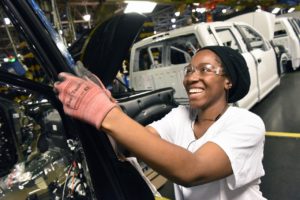Pickup Trucks, Consumer Choice, Jobs, and the Power of Sound Climate Policy
The release of the Technical Assessment Report is the first step of the Midterm Evaluation process for 2017-2025 Light-Duty Fuel Economy and Greenhouse Gas Standards. These standards prove that sound policymaking can effectively combat climate change.
The following blog is from Zoe Lipman, the BlueGreen Alliance’s Senior Policy Advisor.
Today, the U.S. Environmental Protection Agency (EPA), the U.S. Department of Transportation’s National Highway Traffic Safety Administration (NHTSA) and the California Air Resource Board (CARB) jointly released their highly anticipated draft Technical Assessment Report (TAR). The TAR is the first step in the agencies’ “Midterm Evaluation” of landmark fuel economy and greenhouse gas standards for passenger cars and trucks.
The TAR doesn’t make recommendations, but its analysis provides a basis to assess the cost and technical viability of meeting the final year requirements of the fuel economy standards—set to roughly double vehicles’ fuel economy from 2012 levels by 2025. But the review also naturally spurs broader consideration of the standards as a whole.
Whether we’re looking at the data in the TAR or the transformation underway in the auto sector today, it is clear these standards are working. Under these standards, the industry is on track to achieve historic cuts in greenhouse gas (GHG) emissions while providing consumers with major savings at the pump, redefining environmentally-friendly vehicles, and aiding the revival of U.S. manufacturing and job growth. The TAR is over 1,000 pages long, so it will take some time to review in detail, but the report also demonstrates the technical rigor, collaborative process, and serious engagement of stakeholders that has characterized the Administration’s multi-year process of developing and implementing these standards.
In short, the standards provide one of our best examples of how sound policymaking can effectively combat climate change.
In 2007, Congress broke a decades-long stalemate on fuel economy with a bipartisan deal that called for new attribute-based vehicle standards together with policies to encourage manufacture of the next generation of vehicle technology in America. Unlike older standards that made improving fuel economy all about innovation in small cars or adopting specific technologies, this new generation of standards requires that steady fuel economy improvements take place across every vehicle size or “footprint.” This makes today’s standards both more flexible and more effective at reducing fuel use.
Because every type of vehicle must improve, consumers see big fuel savings no matter what kind of vehicle they need. And while average fuel economy across the fleet may vary as the market shifts, deep fuel economy and GHG savings are retained, regardless of whether consumers choose to buy more cars or more SUVs and trucks. For example, the popular Ford F-150 pickup truck achieves 21 percent better fuel economy today than the same vehicle did in 2010.Thanks to the standards, this means that the F-150s sold in 2015 alone will save 25 million barrels of oil and cut 11 million metric tons of carbon dioxide (CO2) over their lifetimes on the road.
But improvements across all vehicles aren’t just good for consumers and the environment. They also mean broader growth in innovation, investment, and jobs across the whole automotive supply chain.
The TAR describes the progress of technology deployment analytically, and here’s what it looks like in practice.
Ford holds over 275 patents on the fuel efficient engine that powers the F150 today, and it is investing and hiring again in its Cleveland engine plant to build the 2017 model. The truck uses fuel saving electric-power steering developed by a company that— with over 5,000 employees—is now the largest employer in Saginaw, Michigan. Innovative aluminum and aluminum-joining technology comes from growing factories in Tennessee, Iowa, and several other states. In Cleveland, Ohio, a hundred year-old integrated steel mill speeded its product development cycle to create a wide range of innovative advanced steels for the automotive market. Idled in 2008, the plant is now operating at full capacity with a union-represented workforce of 1900 and is one the most productive steel mills in the world.
Of course, this is not just a story about Ford or about trucks. If you prefer a Chevy pickup, you can choose an innovative diesel engine built in Ohio that gets car-like fuel economy, or a V8 355-horsepower truck that boosts its fuel economy and performance with electric assist technology drawn from the company’s innovative electric cars.
This is what it looks like to rebuild America’s manufacturing economy and to combat climate change— and we’re doing it today.
Overall, implementation of the first five years of the standards has been simultaneous with dramatic recovery of the industry, fueled by record sales of fuel efficient vehicles of all types. Since 2009, the U.S. auto industry has added nearly 700,000 jobs in manufacturing and at dealerships, and has helped power the first period of sustained U.S. manufacturing job growth since 1999. Studies underscore that job growth in the industry depends not only on the overall recovery, but also on investment in innovative and additional technology driven by the standards, and on policies that drove reinvestment to manufacture advanced vehicle technology in the United States.
America’s manufacturing companies and workers are demonstrating America can lead in both inventing and building the next generation of clean technology, while rebuilding good jobs. When sound environmental and economic policies work together, consumers, the climate, and the economy win.
This is a trajectory America needs to continue.
Photo Credit: Ford Motor Co.
